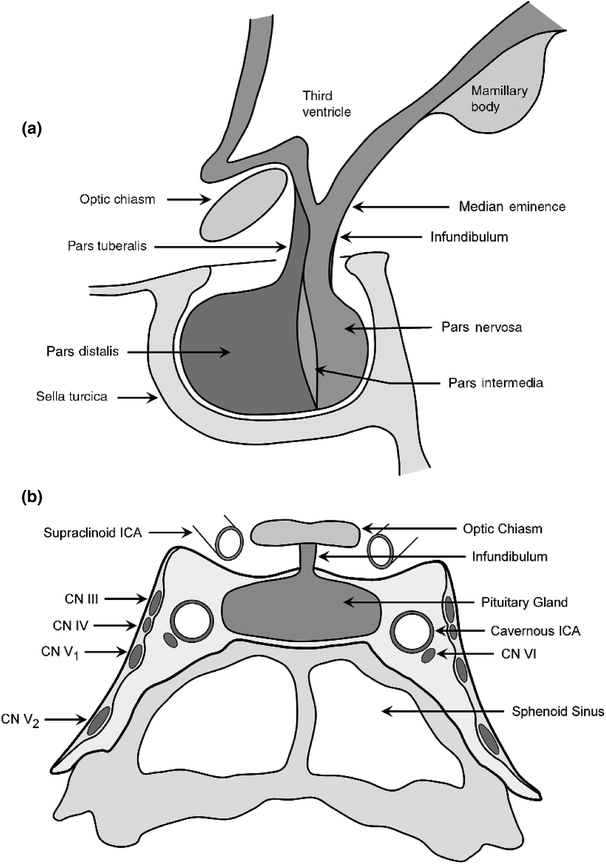Medications:
Simvastatin 20 mg oral daily
Lisinopril 20 mg oral daily
Glyburide 10 mg oral daily
Allergies:
NKA
Past Medical History:
Hypertension
Hyperlipidemia
Obesity
Recent admission with Congestive heart failure
Remote smoker
Physical Exam:
Mandibular
Large coarse facial features
Airway examination: Mallampatti Class 3
CVS S1 S2
BP 170/100 HR 100 RR20
Weight 140 kg, Height 6′, BMI 41.8 kg/m2
EKG Left ventricular hypertrophy
- 1.
What is the anatomy of the pituitary gland?
The pituitary is located within the sella turcica which is the bony roof of the sphenoid sinus. It is made up of the glandular anterior adenohypophysis and posterior neurohypophysis. It is extra dural. The infundibulum, which contains the neurovascular bundle, extends from the hypothalamus to the pituitary gland.
The optic chiasma is above the pituitary gland. On either side of the pituitary are the cavernous sinuses. The cranial nerves III, IV, V, and VI and the cavernous portion of the carotid arteries are on either side of the pituitary within the cavernous sinuses (Fig. 19.1) [1].


Fig. 19.1
Anatomy of the pituitary gland. a Schematic midline sagittal view of the sella turcica, pituitary, gland, and infundibulum. b Schematic coronal view of the cavernous sinuses, ICA, internal carotid artery; CN, cranial nerve. Reproduced from [8]
- 2.
What are the hormones secreted by the pituitary?
The anterior pituitary secretes six hormones: Adrenocorticotropic hormone (ACTH), thyroid-stimulating hormone (TSH), growth hormone (GH), follicle-stimulating hormone (FSH), luteinizing hormone (LH), and prolactin [1].
The posterior pituitary contains nerve endings, which release oxytocin and vasopressin (Antidiuretic hormone ADH), which are formed in supraoptic and paraventricular nuclei of the hypothalamus. Hypothalamic osmoreceptors and peripheral stretch receptors regulate secretion of ADH.
The hypothalamus regulates the anterior pituitary through hypothalamic-releasing factors, which travel down the portal venous system in the pituitary stalk.
- 3.
What are the common types of pituitary tumors?
Pituitary adenomas are classified by size. Tumors that are greater than 1 cm are macroadenomas. Tumors less than 1 cm are microadenomas. They are also classified as functioning or non-functioning. Prolactin, ACTH, and GH secreting tumors are more common than TSH or FSH secreting tumors.
- 4.
What are the clinical presentations of non-functioning pituitary tumors?
Non-functioning adenomas comprise 40% of pituitary adenomas [2].
Examples of non-functioning adenomas include craniopharyngiomas, Rathke’s cleft cyst, chromophobe adenomas, or meningiomas. About 50% of craniopharyngiomas occur in childhood.
They may present with mass effects like hypopituitarism, headaches, and visual deficits from compression of optic chiasma (typically bi-temporal hemianopia) [1, 2].
- 5.
What are the clinical presentations of functioning tumors?
Functioning tumors produce excess secretion of pituitary hormones [2], hyperprolactinemia, acromegaly, Cushing disease hyperthyroidism or diabetes insipidus [2].
Either functioning or non-functioning pituitary tumors can in rare instances cause raised intracranial pressure (ICP) by directly compressing the third ventricle and the patient may present with signs of raised ICP like headache, nausea, vomiting, and papilledema [1].
Pituitary tumors may present with pituitary apoplexy due to sudden enlargement of the tumor or hemorrhage into tumor.
Extension into the cavernous sinuses can produce diplopia, ophthalmoplegia, ptosis, and facial sensory syndromes due to cranial nerve involvement [1, 2].
Hydrocephalus can occur from compression of third ventricle from suprasellar extension.
- 6.
What are the findings in a patient with prolactin secreting tumor?
Prolactinomas are the most frequently occurring hyper-functioning pituitary adenoma. Hyperprolactinemia in women causes amenorrhea, loss of libido, and infertility [1].
In men it causes decreased libido, erectile dysfunction, premature ejaculation, and oligospermia
- 7.
What are the concerns in a patient with growth hormone secreting tumors?
Growth hormone secreting tumors can produce gigantism in patients before epiphyseal plates are fused and Acromegaly in adults [2].
Patients with acromegaly have cardiovascular, respiratory, endocrinologic, and musculoskeletal issues, which need to be addressed [1–3].
Cardiovascular issues:
- (a)
Maybe from interstitial myocardial fibrosis
- (b)
Hypertension
- (c)
Cardiac hypertrophy,
- (d)
Diastolic dysfunction, conduction defects like bundle branch block
- (e)
Cardiomyopathy
- (f)
Congestive heart failure
Respiratory:
- (a)
Coarse facial features can cause difficult mask ventilation
- (b)
Thickening of laryngeal and pharyngeal tissues leading to reduction of glottis opening
- (c)
Macroglossia
- (d)
Prognathism and malocclusion
- (e)
Hypertrophy of epiglottis, aryepiglottic folds, and arytenoid cartilage
- (f)
All of the above contribute to obstructive sleep apnea and difficulty in airway management.
Endocrine:
- (a)
Diabetes is common
- (b)
Glucose intolerance
Musculoskeletal:
- (a)
Arthritis
- (b)
Vertebral hypertrophy
- (c)
Osteophyte formation of cervical spine and reduced range of motion of neck
- (d)
Osteoporosis
- (e)
Enlargement of hands and feet
- (f)
Carpal tunnel syndrome
- 8.
What is the cause of hoarseness in acromegaly?
The causes of hoarseness in acromegaly patients can be possible laryngeal stenosis, or recurrent laryngeal nerve injury.
- 9.
What is the grading for airway involvement in acromegaly patients?
Four grades of airway involvement are described [4]:
- (a)
Grade 1—no significant involvement
- (b)
Grade 2—nasal and pharyngeal mucosa hypertrophy but normal cords and glottis
- (c)
Grade 3—glottic involvement including glottic stenosis or vocal cord paresis
- (d)
Grade 4—combination of grades 2 and 3, i.e., Glottic and soft tissue abnormalities
Grade 3 and 4 may need to awake fiberoptic intubation
- 10.
What are the features of adrenocorticotrophic hormone (ACTH) excess?
Stay updated, free articles. Join our Telegram channel

Full access? Get Clinical Tree





